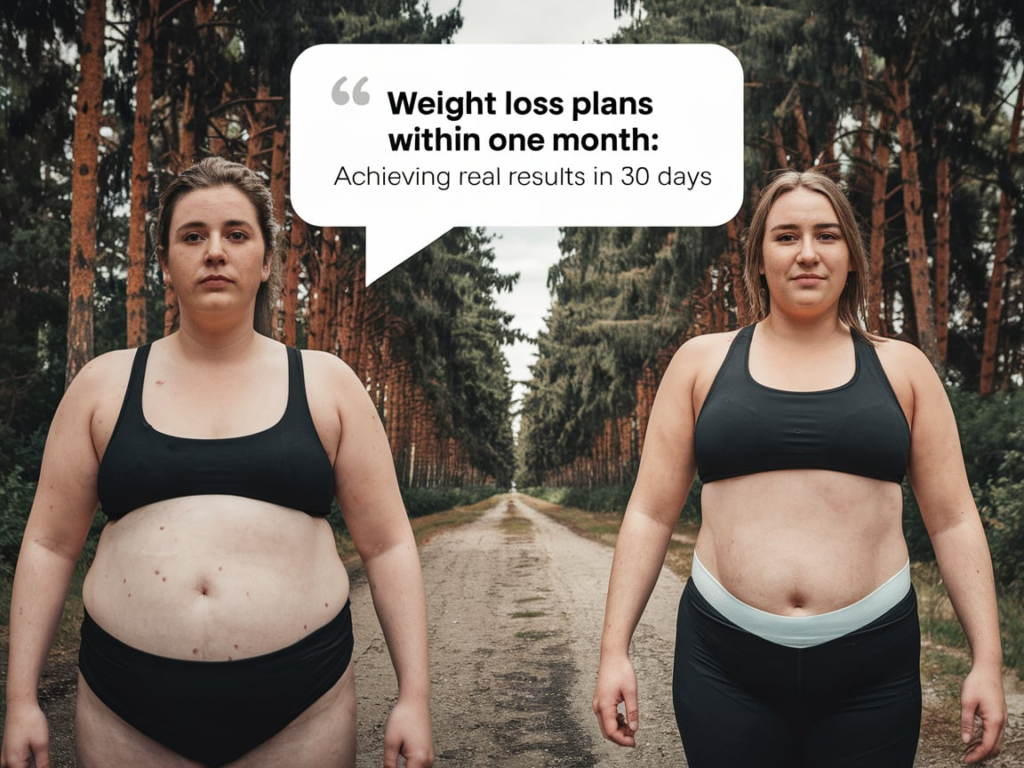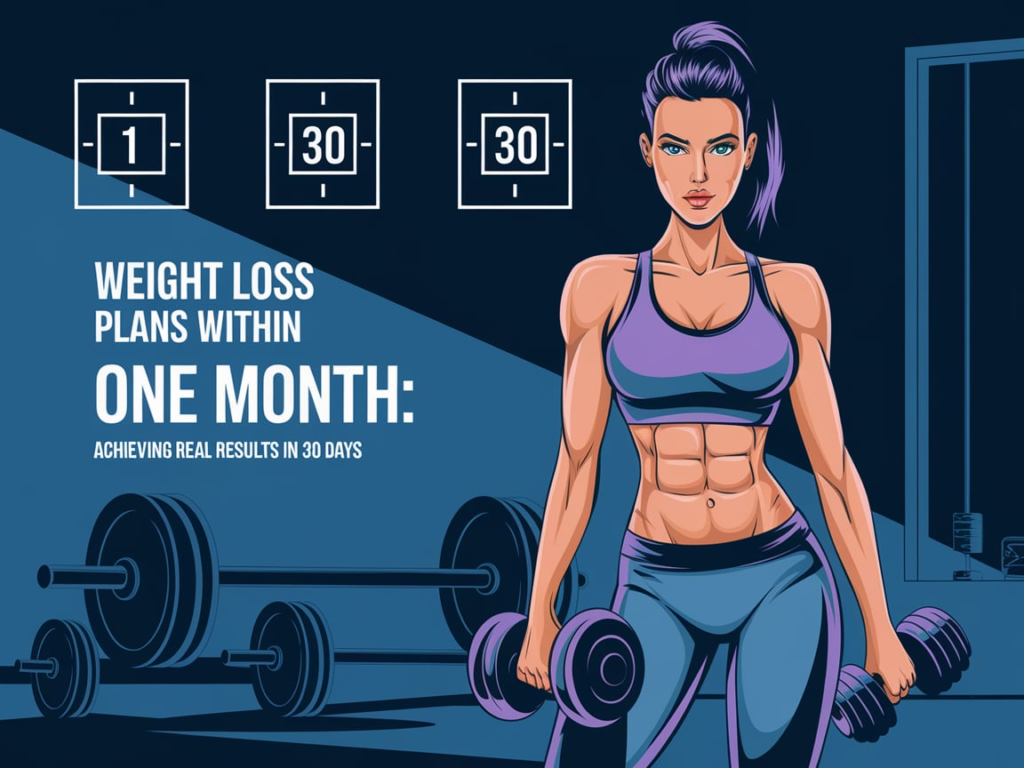
"Transform your body in just 30 days with a balanced weight loss plan that combines healthy eating, regular exercise, and mindful habits. Start your journey today!"
Meta Description:
Looking for effective weight loss plans to follow within a month? Learn about practical and achievable strategies for losing weight, the best exercises, meal plans, and tips to help you succeed in your journey.
Introduction

Losing weight can feel like an overwhelming challenge, especially when you are working with a tight timeline. However, a month can be enough to kick-start your weight loss journey and see noticeable results. The key lies in adopting a structured plan that integrates balanced eating, effective exercise routines, and sustainable lifestyle changes. If you’ve been looking for ways to lose weight in a month, this article will guide you through a practical, healthy, and realistic plan for shedding those extra pounds.
Whether your goal is to lose 5 or 15 pounds, a one-month time frame provides a solid foundation for progress. However, it’s essential to approach it with a healthy mindset. Quick fixes, crash diets, or extreme measures can harm your health and leave you with unsustainable results. Instead, focusing on sustainable habits will help you lose weight safely, gradually, and, most importantly, maintain it.
Understanding Weight Loss

Before diving into specific plans, it’s important to understand the science behind weight loss. At its core, weight loss occurs when you burn more calories than you consume. This is referred to as a “caloric deficit.” In other words, if you eat fewer calories than your body needs to maintain its current weight, it will start using stored fat for energy, leading to weight loss.
While exercise can contribute to creating a caloric deficit, nutrition plays a significant role. Focusing on the right balance of calories, nutrients, and physical activity will set you on the right path to achieving your weight loss goals within a month.
Key Principles for Effective Weight Loss

1. Create a Caloric Deficit Creating a caloric deficit is the cornerstone of any weight loss plan. The goal is to burn more calories than you take in through food and drink. A deficit of 500 to 1,000 calories per day can result in a weight loss of approximately 1-2 pounds per week, which is considered healthy and sustainable.
To create a caloric deficit, you can either reduce your caloric intake, increase physical activity, or ideally, combine both. Aim for a moderate deficit to avoid feeling deprived and to ensure you’re still getting the necessary nutrients.
2. Focus on Whole, Nutrient-Dense Foods Rather than turning to fad diets or cutting out entire food groups, focus on eating whole, nutrient-dense foods that are packed with vitamins, minerals, and fiber. This includes:
- Vegetables and fruits
- Lean proteins like chicken, turkey, tofu, and fish
- Whole grains like quinoa, brown rice, and oats
- Healthy fats from sources like avocado, nuts, seeds, and olive oil
These foods not only provide essential nutrients but also help you feel full longer, reducing cravings and overeating.
3. Portion Control Even healthy foods can contribute to weight gain if eaten in excess. Practice portion control to avoid overeating. One way to do this is by using smaller plates or bowls, which naturally reduce portion sizes. You can also track your food intake using apps or journals to ensure you stay within your calorie goals.
4. Exercise Regularly Exercise is an essential component of any weight loss plan. Incorporating both cardio and strength training exercises into your routine can help burn calories and build muscle, which increases your metabolism. Aim for at least 150 minutes of moderate-intensity exercise per week, such as brisk walking, cycling, or swimming.
Strength training exercises, like lifting weights or doing bodyweight exercises (e.g., squats, push-ups), are equally important for building muscle and improving your overall body composition.
5. Stay Hydrated Drinking enough water is vital for weight loss. Sometimes, our bodies confuse thirst with hunger, which can lead to overeating. Drinking water throughout the day helps with digestion, keeps you feeling full, and supports your body’s metabolic processes. Aim for at least 8 cups (64 ounces) of water a day, or more depending on your activity level.
6. Get Enough Sleep Sleep is often overlooked when it comes to weight loss, but it’s just as important as diet and exercise. Lack of sleep can disrupt hormones that regulate hunger, leading to increased cravings and overeating. Aim for 7-9 hours of quality sleep each night to support your weight loss efforts.
7. Manage Stress Chronic stress can hinder weight loss by increasing levels of the hormone cortisol, which can lead to weight gain, particularly around the belly area. Incorporating stress management techniques like yoga, meditation, or deep breathing can help you stay focused and avoid emotional eating.
Weight Loss Plan for One Month

Here’s a practical, balanced weight loss plan that you can follow for the next 30 days. Remember that the most effective weight loss plans are those that can be sustained over time. Aim to make small, gradual changes rather than drastic, unsustainable shifts.
Week 1: Build the Foundation
Nutrition:
- Breakfast: Start your day with a protein-rich breakfast, such as eggs or a smoothie with protein powder, spinach, and fruits. Protein will help you feel full and curb cravings later in the day.
- Lunch: Opt for a lean protein (like chicken or tofu) with a side of vegetables and whole grains (such as quinoa or brown rice).
- Dinner: Keep your dinner light but filling with lean proteins, healthy fats, and plenty of vegetables. For example, grilled fish with steamed broccoli and a side of avocado.
- Snacks: Choose healthy snacks like nuts, Greek yogurt, or fruit to avoid processed snacks.
- Hydration: Drink plenty of water throughout the day.
Exercise:
- Cardio: Aim for 30 minutes of moderate-intensity cardio five times a week. This can include activities like brisk walking, cycling, or swimming.
- Strength Training: Start with 2-3 strength training sessions per week, focusing on full-body exercises like squats, lunges, push-ups, and planks.
Week 2: Increase Intensity
Nutrition:
- Continue eating whole, nutrient-dense foods while being mindful of portion sizes.
- Begin to experiment with intermittent fasting if it aligns with your lifestyle. This can help control calorie intake and improve metabolic efficiency.
Exercise:
- Increase your cardio time to 40-45 minutes per session.
- Add more intensity to your strength training by using dumbbells or resistance bands to challenge your muscles.
Week 3: Focus on Consistency
Nutrition:
- Stay consistent with your meal plan, avoiding processed and sugary foods.
- Focus on meal prepping to ensure you stay on track and avoid unhealthy temptations.
Exercise:
- Incorporate High-Intensity Interval Training (HIIT) into your routine to boost fat burning. HIIT involves short bursts of intense activity followed by rest periods and is a great way to burn calories quickly.
- Keep up with strength training, aiming to target different muscle groups.
Week 4: Fine-Tune Your Routine
Nutrition:
- Reevaluate your progress and adjust your caloric intake if needed. If you’re losing weight too quickly, you may need to eat a bit more. If you’re not seeing results, make sure you’re in a moderate caloric deficit.
Exercise:
- Add variety to your workouts. Try different types of cardio, like jogging, cycling, or a fitness class, to keep your routine interesting.
- Continue strength training with a focus on progressive overload—gradually increasing the weights or repetitions to challenge your muscles further.
Frequently Asked Questions (FAQs)

1. How much weight can I realistically lose in one month? On average, you can expect to lose between 4-8 pounds in a month if you follow a healthy diet and exercise plan. However, individual results vary based on factors like metabolism, current weight, and adherence to the plan.
2. Can I lose weight without exercise? While it’s possible to lose weight through diet alone by maintaining a caloric deficit, exercise significantly speeds up the process, helps maintain muscle mass, and supports overall health.
3. What foods should I avoid while trying to lose weight? Avoid processed foods, sugary snacks, sugary beverages, fried foods, and refined carbs. Instead, focus on whole foods like vegetables, lean proteins, fruits, and healthy fats.
4. Is intermittent fasting safe for weight loss? Intermittent fasting can be an effective tool for weight loss, as it helps control calorie intake. However, it’s important to approach it carefully and listen to your body’s needs. If you have any health conditions, consult with a doctor before trying intermittent fasting.
5. How can I stay motivated to lose weight? Stay motivated by setting small, realistic goals, tracking your progress, celebrating milestones, and surrounding yourself with a supportive community. Keep in mind that consistency is key.
Conclusion
Achieving weight loss in one month is entirely possible with the right plan. By following a balanced diet, regular exercise routine, and healthy lifestyle changes, you can see noticeable results and build the foundation for long-term success. Remember, the key to lasting weight loss is sustainability. Avoid extreme measures and focus on creating habits that you can maintain well beyond the 30-day mark.
Stay patient, stay consistent, and be kind to yourself along the way. Your weight loss journey is a marathon, not a sprint, and every step you take brings you closer to your goal.
Additional Resources and Links:
- Harvard T.H. Chan School of Public Health – Weight Loss
- National Institute of Diabetes and Digestive and Kidney Diseases
- Mayo Clinic – Weight Loss and Healthy Dieting
- American Heart Association – Diet and Lifestyle Recommendations
By following a structured, sustainable weight loss plan and taking advantage of these resources, you’ll be well on your way to achieving your goals in just one month.




